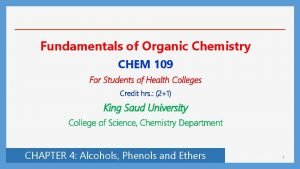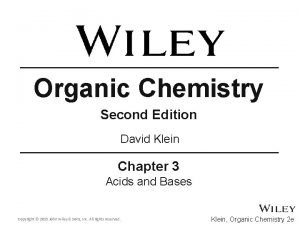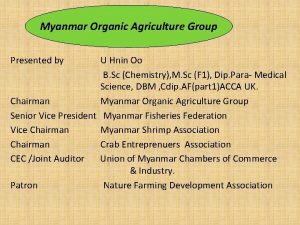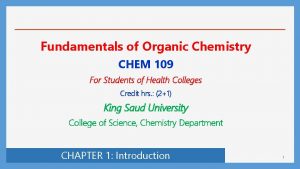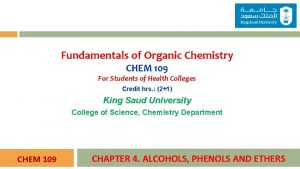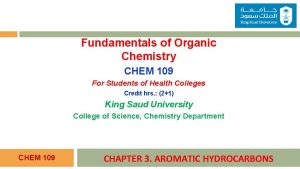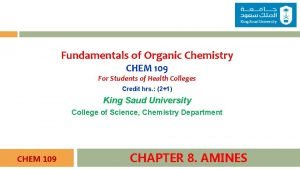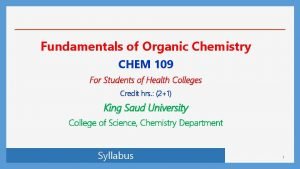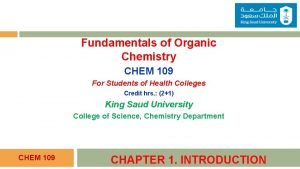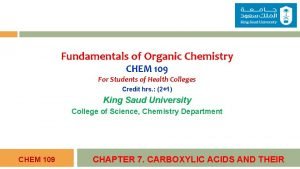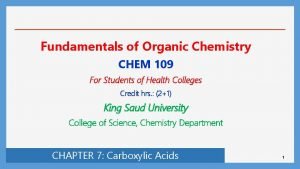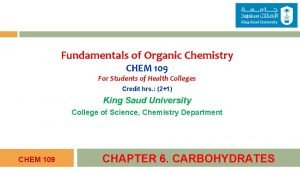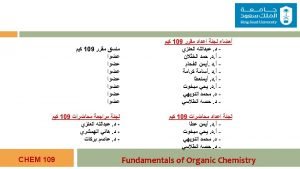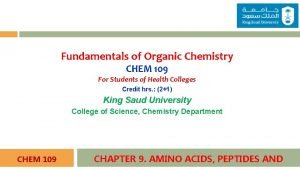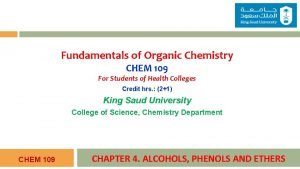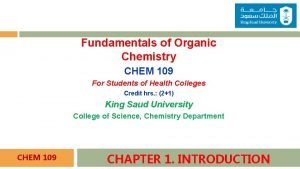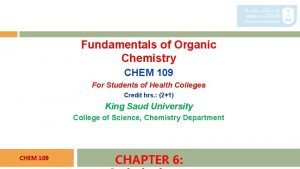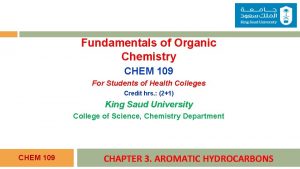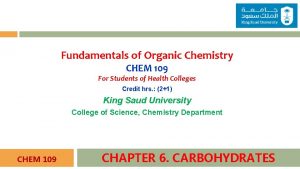Fundamentals of Organic Chemistry CHEM 109 For Students

























- Slides: 25

Fundamentals of Organic Chemistry CHEM 109 For Students of Health Colleges Credit hrs. : (2+1) King Saud University College of Science, Chemistry Department CHAPTER 6: Carbohydrates 1

Carbohydrates o The word carbohydrate can be expressed as hydrates of carbon because molecular formulas of these compounds. o Example; Glucose has the molecular formula C 6 H 12 O 6, which might be written as C 6(H 2 O)6. polyhydroxyaldehydes polyhydroxyketones o Carbohydrates are usually classified according to their structure as monosaccharides, oligosaccharides, or polysaccharides. The term saccharide comes from Latin (saccharum, sugar) and refers to the sweet taste of some simple carbohydrates. 2

Carbohydrates o The three classes of carbohydrates are related to each other through hydrolysis. o Monosaccharides (or simple sugars) are carbohydrates that cannot be hydrolyzed to simpler compounds. o Oligosaccharides (from the Greek oligos, few) contain at least two and generally no more than a few linked monosaccharide units. They may be called disaccharides, trisaccharides, and so on, depending on the number of units, which may be the same or different. Example; Maltose is a disaccharide made of two glucose units. Sucrose is made of two different monosaccharide units: glucose and fructose. o Polysaccharides contain many monosaccharide units - sometimes hundreds or even thousands. o Example; Starch and cellulose, contain linked units of the same monosaccharide, glucose. 3

Monosaccharides o Glyceraldehyde is the simplest aldose, and dihydroxyacetone is the simplest ketose. o Each is related to glycerol in that each has a carbonyl group in place of one of the hydroxyl groups. o Monosaccharides are classified according to: § The number of carbon atoms present (triose, tetrose, pentose, hexose, and so on). 4

Monosaccharides 5

Monosaccharides Chirality in Monosaccharides; Fischer Projection Formulas and D, L-Sugars o He used a small capital d to represent the configuration of § D-glyceraldehyde, with the hydroxyl group on the right. § L-glyceraldehyde, with the hydroxyl group on the left. 6

Monosaccharides o Stereogenic centers are mostly carbon atoms (asymmetric carbon) that bind four different groups. o Stereoisomers = 2 n (n = number of stereogenic centers). o Each of those stereoisomers has its enantiomer (mirror image) (2 pairs of enantiomers). o Diastereomers are stereoisomers that differ from the particular pair of enantiomers. o Diastereomers differ in their properties. Enantiomers Diastereomers 7

Monosaccharides o Epimers; A special name is given to diastereomers that differ in configuration at only one stereogenic center. o Examples; D-glucose and D-mannose are epimers (at C-2). D-glucose and D-galactose are epimers (at C-4). 8

The Cyclic Hemiacetal Structures of Monosaccharides o Monosaccharides exist mainly in cyclic, hemiacetal forms and not in the acyclic aldo- or keto-forms. Manipulation of the Fischer projection formula of D-glucose to bring the C -5 hydroxyl group in position for cyclization to the hemiacetal form. 9

Haworth Projection o The carbons are arranged clockwise numerically, with C-1 at the right. o Substituents attached to the ring lie above or below the plane. § Carbons 1 through 5 are part of the ring structure, but carbon 6 (the -CH 2 OH group) is a substituent on the ring. § C-1 is special. C-1 is the hemiacetal carbon (it carries a hydroxyl group, and it is also connected to C-5 by an ether linkage). § C-2, C-3, and C-4 are secondary alcohol carbons. § C-6 is a primary alcohol carbon. § Hydroxyl groups on the right in the Fischer projection are down in the Haworth projection (and conversely. § hydroxyl groups on the left in the Fischer projection are up in the Haworth projection). § For D-sugars, the terminal -CH 2 OH group is up in the Haworth projection; for L-sugars, it is down. 10

Anomeric Carbons; Mutarotation o Anomeric carbon; The hemiacetal carbon, the carbon that forms the new stereogenic center. o Anomers; Two monosaccharides that differ only in configuration at the anomeric center are (a special kind of epimers). o Anomers are called or , depending on the position of the hydroxyl group. o For monosaccharides in the D-series, the hydroxyl group is “down” in the anomer and “up” in the anomer. 11

Conformations of Pyranoses; Chair Conformation o At the anomeric carbon (C-1), where the hydroxyl group may be axial (in the anomer) or equatorial (in the anomer). 12

1) Reduction of Monosaccharides Reactions of Monosaccharides o The carbonyl group of aldoses and ketoses can be reduced by various reagents to give polyols, called alditols. o Example; Catalytic hydrogenation or reduction with sodium borohydride (Na. BH 4) converts D-glucose to Dglucitol (sorbitol). o Sorbitol is used commercially as a sweetener and sugar substitute. 13

2) Oxidation of Monosaccharides Reactions of Monosaccharides 2. 1. With Mild Oxidizing Agents o Mild oxidizing agents as - Tollens’ reagent (Ag+ in aqueous ammonia), Fehling’s reagent (Cu 2+ complexed with tartrate ion), Benedict’s reagent (Cu 2+ complexed with citrate ion). o These aldehyde groups can be easily oxidized to acids which are called aldonic acids. o A carbohydrate that reacts with Ag+ or Cu 2+ is called a reducing sugar o Example; D-glucose is easily oxidized to D-gluconic acid. o With the copper reagents, the blue solution gives a red precipitate of cuprous oxide, Cu 2 O. 14

2) Oxidation of Monosaccharides Reactions of Monosaccharides 2. 2. With Strong Oxidizing Agents o Stronger oxidizing agents, such as aqueous nitric acid. o The aldehyde group and the primary alcohol group can be oxidized, producing dicarboxylic acids called aldaric acids. o Example; D-glucose gives D-glucaric acid. 15

Disaccharides o The most common oligosaccharides are disaccharides. o In a disaccharide, two monosaccharides are linked by a glycosidic bond between the anomeric carbon of one monosaccharide unit and a hydroxyl group on the other unit. 16

Maltose o o Disaccharides Maltose is the disaccharide obtained by the partial hydrolysis of starch. Further hydrolysis of maltose gives only D-glucose. Maltose consist of two linked glucose units. It turns out that the anomeric carbon of the left unit is linked to the C-4 hydroxyl group of the unit at the right as an acetal (glycoside). o The configuration at the anomeric carbon of the left unit is . 17

Cellibiose Disaccharides o Cellobiose is the disaccharide obtained by the partial hydrolysis of cellulose. o Further hydrolysis of cellobiose gives only D-glucose. o Cellobiose must therefore be an isomer of maltose. o In fact, cellobiose differs from maltose only in having the configuration at C-1 of the left glucose unit. 18

Lactose Disaccharides o Lactose is the major sugar in human and cow’s milk (4% to 8% lactose). o Hydrolysis of lactose gives equimolar amounts of D-galactose and D-glucose. o The anomeric carbon of the galactose unit has the configuration at C-1 and is linked to the hydroxyl group at C-4 of the glucose unit. 19

Sucrose Disaccharides o The most important commercial disaccharide is sucrose, ordinary table sugar. o Sucrose occurs in all photosynthetic plants, where it functions as an energy source. o It is obtained commercially from sugar cane and sugar beets, in which it constitutes 14% to 20% of the plant juices. o Sucrose is very water soluble (2 grams per milliliter at room temperature) because it is polar due to the presence of eight hydroxyl groups on its surface. o Hydrolysis of sucrose gives equimolar amounts of D-glucose and the ketose D-fructose. 20

Polysaccharides o Polysaccharides contain many linked monosaccharides and vary in chain length and molecular weight. o Most polysaccharides give a single monosaccharide on complete hydrolysis. o The monosaccharide units may be linked linearly, or the chains may be branched. 21

Starch Polysaccharides 22

Starch Polysaccharides o Starch is the energy-storing carbohydrate of plants. o It is a major component of cereals, potatoes, corn, and rice. o Starch is made up of glucose units joined mainly by 1, 4 - -glycosidic bonds, although the chains may have a number of branches attached through 1, 6 - -glycosidic bonds. o Partial hydrolysis of starch gives maltose, and complete hydrolysis gives only D-glucose. o Starch can be separated by various techniques into two fractions: amylose and amylopectin. § Amylose, which constitutes about 20% of starch, the glucose units (50 to 300) are in a continuous chain, with 1, 4 linkages. § Amylopectin is highly branched. Although each molecule may contain 300 to 5000 glucose units, chains with consecutive 1, 4 links average only 25 to 30 units in length. o These chains are connected at branch points by 1, 6 linkages. 23

Glycogen Polysaccharides o Glycogen is the energy-storing carbohydrate of animals. o Like starch, it is made of 1, 4 - and 1, 6 -linked glucose units. o Glycogen has a higher molecular weight than starch (perhaps 100, 000 glucose units), and its structure is even more branched than that of amylopectin, with a branch every 8 to 12 glucose units. o Glycogen is produced from glucose that is absorbed from the intestines into the blood; transported to the liver, muscles, and elsewhere; and then polymerized enzymatically. o Glycogen helps maintain the glucose balance in the body by removing and storing excess glucose from ingested food and later supplying it to the blood when various cells need it for energy. 24

Cellulose Polysaccharides o Cellulose is an unbranched polymer of glucose joined by 1, 4 - -glycosidic bonds. o It consists of linear chains of cellobiose units. o These linear molecules, containing an average of 5000 glucose units, aggregate to give fibrils bound together by hydrogen bonds between hydroxyls on adjacent chains. o Cellulose fibers having considerable physical strength are built up from these fibrils, wound spirally in opposite directions around a central axis. o Wood, cotton, hemp, linen, straw, and corncobs are mainly cellulose. 25
 Chem 109
Chem 109 Functional groups ib chemistry
Functional groups ib chemistry Inorganic vs organic chemistry
Inorganic vs organic chemistry Crash course chemistry naming compounds
Crash course chemistry naming compounds Ario organic chem
Ario organic chem Founder of organic chemistry
Founder of organic chemistry Chemistry of soap making
Chemistry of soap making Ester organic chemistry
Ester organic chemistry But-1-ene
But-1-ene Transition state energy diagram
Transition state energy diagram Ee organic chemistry
Ee organic chemistry Ario organic chemistry
Ario organic chemistry Organic chemistry (3rd) edition chapter 1 problem 16s
Organic chemistry (3rd) edition chapter 1 problem 16s Organic chemistry david klein 3rd edition
Organic chemistry david klein 3rd edition Is alkane an organic compound
Is alkane an organic compound Leveling effect organic chemistry
Leveling effect organic chemistry Functional group vs substituent
Functional group vs substituent Organic chemistry lab report sample
Organic chemistry lab report sample Alkane organic chemistry
Alkane organic chemistry Organic chemistry grade 10
Organic chemistry grade 10 Cyclo organic chemistry
Cyclo organic chemistry Importance of organic chemistry
Importance of organic chemistry Kiliani fischer synthesis
Kiliani fischer synthesis Fractional distillation of petroleum
Fractional distillation of petroleum What is chemistry
What is chemistry Organic chemistry myanmar
Organic chemistry myanmar
